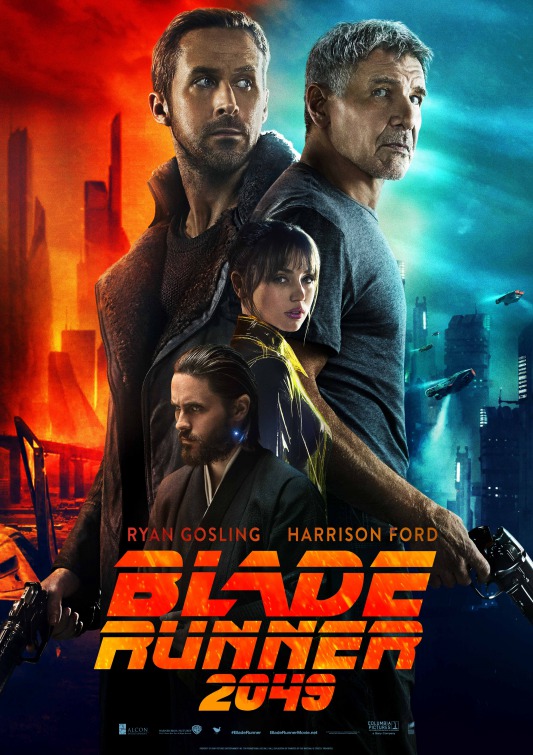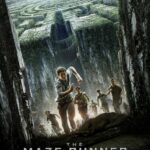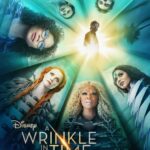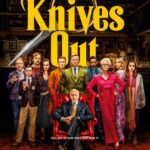30 Years Later
Director
Denis Villeneuve
Starring
Ryan Gosling
Ana De Armas
Sylvia Hoeks
Harrison Ford
Thirty years after the events in Blade Runner, the Earth has suffered a massive blackout and seemingly all digital data is erased. Lifting the world out of chaos is the Wallace company (Wallace being played by Jared Leto) who buyout the tarnished Tyrell replicant brand and start production anew, creating docile, obedient androids. This renaissance allows mankind to prosper once more and life continues with synthetic people immersed and integrated into everyday society. Older Nexus models, however, are still hunted down by a division of the LAPD called Blade Runners. The story follows one such cop, a replicant named K [Gosling] who, in uncovering a thirty year old skeleton, unearths a revelation that could upset the natural order.
Much like its predecessor, Blade Runner 2049 is visually breath-taking, an absolutely stunning and captivating feast for the senses that is designed to consume and overwhelm in its grandiosity and beautiful horror. Rife with plenty of noir nods, the story is methodically and masterfully paced, taking its time to unfold, allowing the actors, sets and developments to seemingly naturally speak for themselves rather than rushing to conclusions and reiterating developments with the zeal of flogging a dead horse. The whole thing is a truly hyper-stylistic dream, evocative of the works of Tarsem Singh. The majority of this lavishness comes down to the wonderful production design, which feels like a natural progression within the universe established by the original. Both high-tech and lo-fi this movie shows a world that we saw before which has moved on but retains its uniqueness and identity. The two most recent examples that I can think of are Star Wars: The Force Awakens and, oddly, Alien: Isolation. While a lot of sound work gives way to visuals, being the oft-neglected lesser sibling, this is far from the case here. Much like Villeneuve’s Sicario and Arrival the sound design is exceptionally powerful and the music is fittingly intense and tribal. But I’m not just praising it for being loud and ominous, it’s just as clever and wonderful in its subtlety; the use of Peter And The Wolf is particularly brilliant.
Blade Runner 2049 is very much carried on Gosling’s shoulders with a sea of interesting short supporting roles and is a sublime lesson in minimalist acting. As far as K’s case goes, the content is very straightforward but so much is offered with the slightest facial contortion. As for the aforementioned supporting roles, they are not only perfectly cast but perfectly managed. No one is over or underused; call-backs are rewarding but restrained and new characters serve a world-building purpose outside of just expositing. Ana De Armas is absolutely crushing as the innocent AI Joi, Robin Wright exudes control marvellously as the career cop who understands the benefits and necessities of replicants, Sylvia Hoeks’ Luv is a fascinating character who will no doubt be studied for years to come in her devotion and twisted emotional programming and the absurdity of Wallace plays perfectly into Leto’s hands, allowing him to be a weirdy-beardy while still having a grounded place as a megalomaniacal CEO. Having said all that I’m not entirely sure why Gaff became Colonel Sanders but I appreciated the cameo all the same. The most interesting addition is that, despite featuring so heavily in the trailer, Harrison Ford is merely a footnote, he features in all of four or five scenes and while he plays an integral role, the story doesn’t hinge on his presence to be a success. Which is a tricky thing to note as the narrative effectively does. I’ll expand on this conflict between logic and emotion later but the strange paradox between making something a necessity but not treating it as one is mind boggling.
Being a Blade Runner film, aside from hitting the right aesthetic notes, success is dependent upon thematic discussion points and Blade Runner 2049 is rife with complex issues that one could analyse for months. Picking up the mantle from the first film, shots of eyes and eye related devices are prevalent throughout but building on that, this film relishes in showing us the reverse, focusing on voyeuristically staring at the back of people’s heads. Whether in close up or tracking from a distance, the back of character’s heads seems to play equal importance to the focus on eyeballs. Another present theme is the inherent attitude to evolved slavery and racism; initially starting off by drawing an intense and impressive comparison between slavery and machines before showing us literal child slave labour highlighting the cyclical nature of abuse and how, even with an alternative, the vulnerable will always be exploited.
One of the other key themes which carries over from the original is the continuing discussion about the varying levels of AI and consciousness, the debate about what is real, what is experience and what does it mean to be alive? Reflecting our own times and technological progression, the film adds another layer to the argument in the form of Joi. Much in the way that replicants were created to assist mankind as an imitation, the machines (through Wallace’s company) then create a limited conscious entity, devoid of physical form. Taking an android being – in the form of K – and giving him an effectively less developed, innocent version of himself – Joi – to interact with and essentially teach, gives the narrative another clever opportunity to address the nature of existence and living; somewhat reminiscent of elements present in recent releases like Ex Machina and Her. On top of that they manage to do the “Whoopi kiss” from Ghost but it’s done so very well. I’m sure the technique is an extremely simple one but synching up performances like that is genuinely masterful from each level of the filmmaking process. Additionally, while holograms were present in the original, the inclusion of the Las Vegas holograms, performing on a loop for all eternity, illustrates the idea of immortality, the idea that like all legends you can be owned and preserved for all time; your form is merely a pattern which can be replicated and fitted to whatever the user desires. Again, very fitting considering how many actors are being de-aged and recreated with CGI in a fair amount of contemporary high-budget releases.
**Several spoiler-heavy plot points are addressed toward the end of the paragraph**
Despite everything, I should point out that this isn’t a perfect film; glorious sequel and beautiful storytelling but imperfect. Admittedly, my first gripe is a minimal one and it’s that the clues were well-presented so I figured out the ending early in the film. Secondly the narrative closure is negated for emotional closure. So coming back to what I said earlier – about the paradox between what is presented and what is required being somehow both present and absent – this movie ends perfectly yet there are so many unresolved issues; not too dissimilar to how Sicario closed. What happened to Wallace, does his story and quest for the next level of replicant just continue? Is there any fallout to the events that took place at the LAPD – again, which can be tracked back to Wallace? Who placed the incinerator memory in K? Was this an accident/intentional/a cry for help? Even if it was a case of merely drawing from personal experience and real life, why did Ana Stelline react in the way she did? Speaking of Ana, does she know what she is or of her significance? And then there’s Freysa’s replicant army, the disgruntled workforce poised to upset the balance and lead a revolution. What about them? As stated, the intensity of the emotional close gives us a satisfying conclusion to the extent that these other elements simply become inconsequential background static, irrelevant to the personal revelations. And while that’s all well and good it leaves an unpleasant lingering, like a tinnitus whine in the eardrum because as much as I can accept that we don’t need answers to appreciate what has unfolded at the end of this film, it leaves the door open for a lot of (potentially) very poorly handled sequels. But this remains to be seen.
Much like the original, Blade Runner 2049, with its slow narrative, bold visuals and complex themes, is not going to please everyone – but equally it doesn’t try to. Too many sequels forget what made the original good and try to cast a wider net to capture a bigger audience. Sticking to what works and furthering the natural evolution of the story should be the staple of any sequel but it’s a bit of a strange rarity. In doing so, this instalment is easily better than the original – largely as it didn’t need three attempts to get it right – but simultaneously while a sequel can improve upon a story no end, it cannot surpass what came before because it needs the original to exist; to use a technological comparison, any upgraded computer owes its existence to its progenitor. But to put all of that to one side for a second, striking a balance between mainstream developments and high art subtext, Blade Runner 2049 is a worthy companion which was more than worth the wait.
Release Date:
6th October 2017
The Scene To Look Out For:
**Spoilers throughout**
The entire film shifts in effectively two looks and it highlights how absolutely every element of this film is firing on all cylinders. Wanting to discern if an implanted memory in his head is real or not, K visits Dr Ana Stelline, who has an ability to craft the best memories. Owing to a fragile immune system, she lives in a dome and creates histories and backstories based on fabrication, designed to evoke an emotional response linked to a moral core. K allows Ana to see the memory and she ascertains it is real, triggering a violent emotional response from K. It’s maybe a few minutes long but absolutely everything at work in this film, from the nature of perception, cages, prisoners, slaves, reality, falsehoods, life, death, consciousness and experience, is present in this scene. The acting is patient and deceptive in its significance, highlighting the wealth that can be conveyed with such subtlety. I also particularly liked that the construction of memories bears a lot of similarities to the construction of film – the device Dr Stelline uses even looks like a sort of telephoto lens.
Notable Characters:
Several sections of the film deal with the idea of experiencing existence on a physical level. One of the most overt ways this is done is a character holding up their hand and watching as the world simply happens to and around them; rain, snow , bees, all manner of tactile items to define what is real. While Blade Runner toyed with the idea of perceptions of the world, it never really explored the inception of those perceptions. Enter Joi. Joi is such a beautifully naïve and emotional character who experiences the world with childlike wonder and innocence; an innocence which K, who is either programmed to be as cynical as humanity or has simply adopted it over time, both enjoys and very possibly envies. This can get irritating but De Armas portrays the character so spectacularly that she is this delightful, impossible being that is both diverse and unique.
Highlighted Quote:
“The world is built on a wall, it separates mankind. Tell the world there’s no wall and you get chaos. Or a slaughter”
In A Few Words:
“Simple in its nature, intricate in its execution, this is a prime example of one of the greatest sequels of all time”
Total Score: 4/5
![The Red Right Hand Movie Reviews [Matthew Stogdon]](https://reviews.theredrighthand.co.uk/wp-content/uploads/2021/12/cropped-header1.png)




